How to Clean Chainsaw Air Filter
- September 24, 2024
- 0 comment

Maintaining a chainsaw is crucial for its performance and longevity, and one of the most important aspects of this maintenance is keeping the air filter clean. A clean air filter ensures that the engine receives the right amount of clean air, which is essential for optimal functioning. This guide will show you how to clean a chainsaw air filter effectively, helping to extend the life of your tool and keep it running smoothly.
In the following sections, we’ll cover why cleaning your chainsaw’s air filter is so important and what you need to prepare for the task. Then, we’ll walk you through a step-by-step process to clean the air filter properly. By the end of this guide, you’ll have the knowledge to keep your chainsaw in top shape, ensuring it’s always ready for your next project.
Table of Contents
- Why Clean Your Chainsaw Air Filter
- Preparing to Clean the Air Filter
- Step-by-Step Cleaning Process
- Conclusion
- Frequently Asked Questions
Why Clean Your Chainsaw Air Filter
The air filter is a small but crucial component of a chainsaw that plays a vital role in keeping the engine clean and functioning optimally. It acts as a barrier, blocking dirt, dust, and debris from entering the carburetor and engine. Without a clean air filter, these contaminants would be pulled into the engine’s internal parts, causing it to work harder, consume more fuel, operate less efficiently, and eventually fail.
Signs of a Dirty Air Filter
There are several indicators that suggest a chainsaw’s air filter needs cleaning:
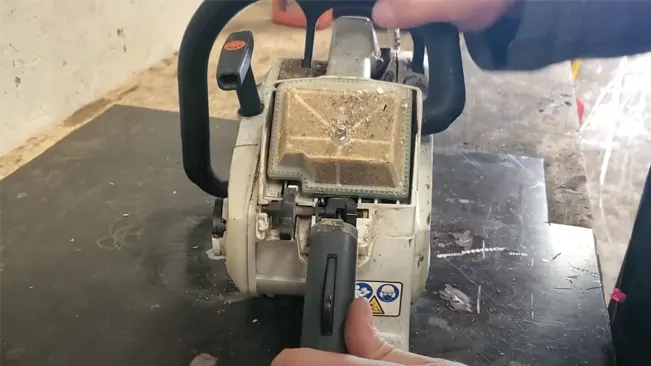
- Increased fuel consumption: If the equipment is using more fuel than usual to accomplish the same amount of work, it may be due to a dirty or clogged air filter.
- Black smoke from the exhaust: This is another sign that the engine isn’t getting the necessary air, resulting in an imbalance of fuel and air.
- Difficulty starting: A small gas engine requires the right amount of air, fuel, and a spark to start. If the engine won’t boot up despite good fuel and a functioning spark plug, a clogged air filter could be the culprit.
- Reduced power and performance: A dirty air filter reduces airflow into the engine, leading to less combustion and decreased horsepower. This can cause the engine to surge up and down or even stop completely while operating.
- Overheating: Blocked, dirty, or damaged filters are one of the main reasons chainsaws overheat.
Importance of Regular Maintenance
Regular maintenance of the chainsaw air filter is crucial for several reasons:
- Optimal performance: A clean air filter ensures the engine receives the right amount of clean air, which is essential for optimal functioning.
- Extended lifespan: Proper maintenance, including regular air filter cleaning, can help extend the life of the chainsaw.
- Prevention of engine damage: The longer a damaged or blocked filter is ignored, the more likely it is to experience other issues, including engine damage.
- Consistent power: Regular cleaning helps maintain the chainsaw’s power and efficiency.
- Cost-effectiveness: Maintaining the air filter is a simple way to get the most value out of the chainsaw.
To maintain optimal performance, it’s recommended to clean the chainsaw air filter after every 10 hours of constant use. However, this frequency may vary depending on working conditions and the type of wood being cut. For homeowners, cleaning twice a year is typically sufficient, while professionals may need to do it weekly or even more frequently.
By understanding the importance of a clean air filter and recognizing the signs of a dirty one, chainsaw users can ensure their tool remains in top condition, ready for any cutting task.
Preparing to Clean the Air Filter
Tools and Materials Needed
To clean a chainsaw air filter effectively, one needs to gather the necessary tools and materials. These include:
- Soft brush
- Warm, soapy water
- Clean water for rinsing
- A towel or cloth for drying
Some chainsaw owners might consider using alternative cleaning methods, such as static fluid spray or an air compressor. However, most manufacturers recommend using soapy water as the default cleaning method.
Safety Precautions
Before beginning the cleaning process, it’s crucial to take proper safety measures:
- Ensure the chainsaw is turned off and cooled down.
- Work in a well-ventilated area, especially if using cleaning products.
- Wear protective gloves to avoid direct contact with dirt and cleaning agents.
- If using an air compressor, keep the pressure below 20 psi to prevent damage to the filter.
It’s important to note that while some might suggest using brake cleaner or gasoline to clean the filter, these methods can be risky. Brake cleaners may contain harsh chemicals that could damage certain plastics or rubber seals. Similarly, soaking the filter in gasoline is not recommended as it can leave residue and pose a fire hazard.
When preparing to clean the air filter, one should also consider the frequency of cleaning. For optimal performance, it’s recommended to clean the chainsaw air filter after every 10 hours of constant use. However, this can vary depending on working conditions and the type of wood being cut. Homeowners might need to clean their filters twice a year on average, while professionals may need to do it weekly or even more frequently.
By properly preparing and following these guidelines, chainsaw users can ensure they’re ready to clean their air filter effectively and safely, maintaining their tool’s performance and longevity.
Step-by-Step Cleaning Process
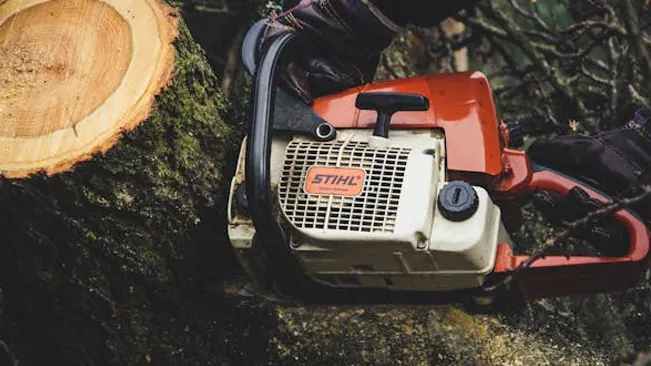
Removing the Air Filter
To begin the cleaning process, one needs to access the air filter. This involves removing the cylinder cover of the chainsaw. Using a flathead screwdriver, the individual should open the three latches on the cylinder cover. Once the cover is removed, they can locate the air filter. The next step is to use the screwdriver to lift and release the metal latch that holds the air filter in place. The filter can then be removed by pulling it straight up.
Cleaning Methods
After removal, the air filter should be inspected for dirt and damage. If the filter is broken or excessively dirty, it’s advisable to replace it. For cleaning, there are two primary methods:
- Dry Cleaning: Using a clean brush, gently remove the dirt and debris from the filter.
- Wet Cleaning: Wash the filter in warm, soapy water and rinse until the water runs clear.
It’s important to note that while some might suggest using brake cleaner or gasoline, these methods can be risky. Brake cleaners may contain harsh chemicals, and gasoline can leave residue and pose a fire hazard.
Drying and Reinstalling
After cleaning, it’s crucial to allow the air filter to dry completely before reinstallation. Once dry, the filter can be reassembled. If the filter comes in two parts, carefully put them back together. When reinstalling, ensure the filter is placed correctly in the chainsaw before putting the cylinder cover back on. Finally, reattach the metal clip to secure the filter in place.
Regular maintenance of the air filter is essential for optimal chainsaw performance. It’s recommended to clean the filter after every 10 hours of constant use, though this may vary depending on working conditions.
Conclusion
Maintaining a clean air filter is key to keeping your chainsaw running smoothly and efficiently. Regular cleaning has a significant impact on the tool’s performance, fuel consumption, and overall lifespan. By following the steps outlined in this guide, chainsaw owners can ensure their equipment stays in top shape, ready to tackle any cutting job with ease.
Remember, the frequency of cleaning depends on how often you use your chainsaw and the conditions you work in. Whether you’re a homeowner who uses the tool occasionally or a professional who relies on it daily, making air filter maintenance a part of your routine is crucial. This simple task can save you time, money, and headaches down the road, keeping your chainsaw running like a well-oiled machine for years to come.
Frequently Asked Questions
1. Why is it important to clean the air filter on a chainsaw?
Cleaning the air filter ensures that dirt, dust, and debris don’t enter the engine, helping maintain optimal performance, fuel efficiency, and extending the life of the chainsaw.
2. How often should I clean my chainsaw air filter?
It’s recommended to clean the air filter after every 10 hours of constant use. However, frequency can vary depending on usage and environmental conditions.
3. What are the signs of a dirty chainsaw air filter?
Indicators include increased fuel consumption, black smoke from the exhaust, difficulty starting, reduced power, and overheating.
4. What tools do I need to clean a chainsaw air filter?
You’ll need a soft brush, warm soapy water, a towel or cloth for drying, and possibly an air compressor if dry cleaning.
5. Is it safe to use gasoline or brake cleaner to clean the air filter?
No, using gasoline or brake cleaner is not recommended as these can damage the filter and pose fire hazards. Warm soapy water is the preferred method.
6. Can I use an air compressor to clean the air filter?
Techniques include felling, limbing, and bucking, each requiring careful planning and execution for safety.
7. How do I remove the air filter for cleaning?
To remove the air filter, you’ll need to take off the cylinder cover by unscrewing the latches. Lift the metal latch securing the air filter and pull the filter out.
8. What’s the best method for cleaning the air filter?
You can either dry clean it with a soft brush or wash it with warm soapy water. Always allow it to dry completely before reinstalling.
9. How long does it take to dry the air filter after cleaning?
It depends on the environment, but it’s best to let the filter air dry for several hours or overnight to ensure no moisture remains.
10. Can a damaged air filter be cleaned or should it be replaced?
If the air filter is excessively dirty, damaged, or torn, it should be replaced to avoid engine damage and ensure proper chainsaw performance.
We hope this guide on cleaning a chainsaw air filter has helped you understand how to keep your tool running efficiently. Regular maintenance ensures better performance and a longer lifespan for your chainsaw.
If you have any tips or experiences, feel free to share them in the comments below. Don’t forget to share this article with fellow chainsaw users to help them maintain their tools. Stay safe and keep cutting!

Edward Smith
Forestry AuthorWoodworking is about more than crafting; it's a harmonious connection with nature, mastering tools, and preserving our environment. I'm here to share my knowledge and experiences with you, forging a future where we can embrace wood's beauty and utility while safeguarding our forests' health and diversity.

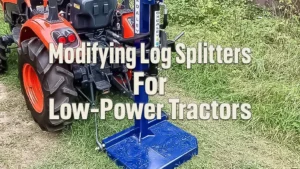








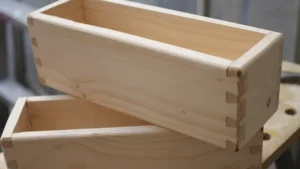
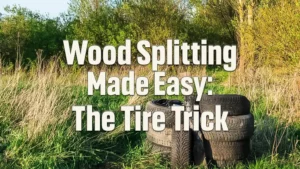

Leave your comment